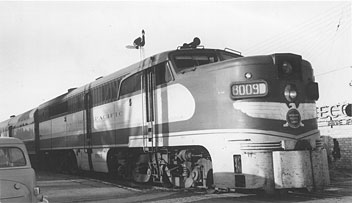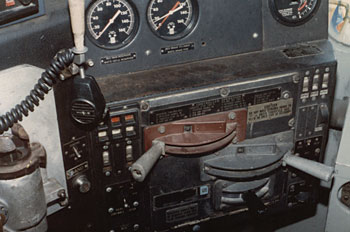|
||||||
| HOME Power Cabooses Rolling Stock MoW Depots | ||||||
|
Steam
|
Switchers
/ Slugs
|
Streamliners
|
1st
Gen Diesel
|
2nd
Gen Diesel
|
Prime
Power
|
Merger
Era
|
Post
Merger Era
|
 |
 |
 |
 |
 |
 |
 |
 |
| 1800s-1930s | 1930s-80s | 1940s | 1950s | 1960s | 1970s | 1980s | Today |
| All | All | All |
GP35 & 28 GP38 GP38-2 U Boats |
SD40 SD40-2 SD40-2c B Boats GP15 & 50 |
All |
Primed with Power - the 1970's-'80's
click on the thumbnails for a larger image
| the SD40-2c |
| MODEL | BUILDER | FIRST DELIVERY | FINAL DELIVERY | TOTAL |
| SD40-2c | EMD | 7/76 | 4/80 | 74 units |
 |
MP 3227 was among the second order of the MP's SD40-2c engines in September '76 - 'c' for coal. These locos were ordered specifically for Wyoming coal service (BN's mainline across Nebraska was occasionally used to access the coal-rich state - Wyoming's coal became important in the '70's for it's cleaner burning qualities). Rated at 3,000 hp, the 40-2c's unique features from other MP 40-2's included dynamic brakes, mars lights, and a roof flasher. - Later models only included dynamic brakes and were numbered into the 6000- series. - © copyright George Elwood photo, used with permission. |
 |
MP 3228 -a new SD40-2c heads up the KSA (Kansas City-San Antonio) train near Buffalo, Kansas. This order of SD40-2s are the only SD units on the MoPac to have dynamic brakes, purchased primarily for unit coal service; September 1976 - Dave Franz photo, from a postcard/T. Greuter collection |
 |
MP 6002 - Now renumbered into the 6000-series (to make room for additional standard SD40-2 purchases), one of the first of MoPac's 40-2c's is doing what it was meant to do - hauling a mile long train of coal cars. This one is in pool service followed by three Burlington Northern units; 6/21/79 - © copyright Glen Beans Photo, used with permission. |
 |
|
 |
MP 6019 - rear perspective - © Brian Paul Ehni photo, used with permission. |
 |
MP 6022 - Jay Glenewinkel Photo |
 |
MP 6038 - parked on the East Fuel Track as viewed facing north at Yard Center Diesel. 1990 - "Tuch" Santucci Photo - J.D. Santucci Photo |
 |
MP 6044 - The control panel for MoPac SD40-2c #6044 - Jay Glenewinkel Photo |
 |
MP 6045 - With the growth in MoPac's loco roster, it was neccasary to renumber the SD40-2c into the higher 6000 -series. What a change of scenery as this unit is seen west of her usual prairie stomping grounds, working on the Rio Grande with an APEX coal haul at Minturn, Colorado in July, 1984 - © copyright Railblazer Photo |
 |
MoPac SD40-2c #6046 - leads a Southbound freight into Sosan Yard in San Antonio, Texas in 1988. - Jay Glenewinkel Photo |
 |
MP SD40-2c #6052 - is seen at the diesel facility at Centennial Yard in Fort Worth, Texas in 1984 - Jay Glenewinkel Photo |
 |
SD40-2C 6056 - basking in the sun at Yard Center Diesel February 1989. This unit is only eleven months newer than the 3268, yet the Screaming Eagle decal has fared much better against the elements and sun over the past nine years. This unit would become UP 3956 when it received a new paint job in a couple of years. - J.D. Santucci Photo |
 |
MP SD40-2c #6060 - is seen in Fort Worth, Texas in 1986. - Jay Glenewinkel Photo |
 |
SD40-2c #6060- this time at Yard Center Diesel 1983. - J.D. Santucci Photo |
 |
MP 6062 - unique view of another SD40-2c joined by lead unit DRGW 5395 and another unidentified MoPac unit. The Rio Grande and the MP had a long history of cooperation. The shared assignment is stopped at Minturn, Colorado in July, 1984 with a train of APEX coal - © copyright Railblazer Photo |
 |
MP 6070 - these SD40-2c's pull through a sanding facility at Fort Worth, Texas in February 1984 - Mike Bledsoe Photo/Jay Glenewinkel Collection. |
 |
MP SD40-2c #6071 - leads two UP units in this 1988 photo in San Antonio, Texas. - Jay Glenewinkel Photo |
 |
MP SD40-2c #6072 - crosses the diamonds at Tower 105 in San Antonio, Texas in 1987. - Steve Schuman Photo/Jay Glenewinkel Collection |
![]()
|
|
Featured
Photographers: Sources: Every effort has been made to get the correct information on these pages, but mistakes do happen. Reporting of any inaccuracies would be appreciated. |
|
trainweb.org/screamingeagle l Last Update
to this page: 18 April, 2008
|
|
| All images & text © 2000-2008 T. Greuter / Screaming Eagles, unless otherwise noted. All Rights Reserved. | |